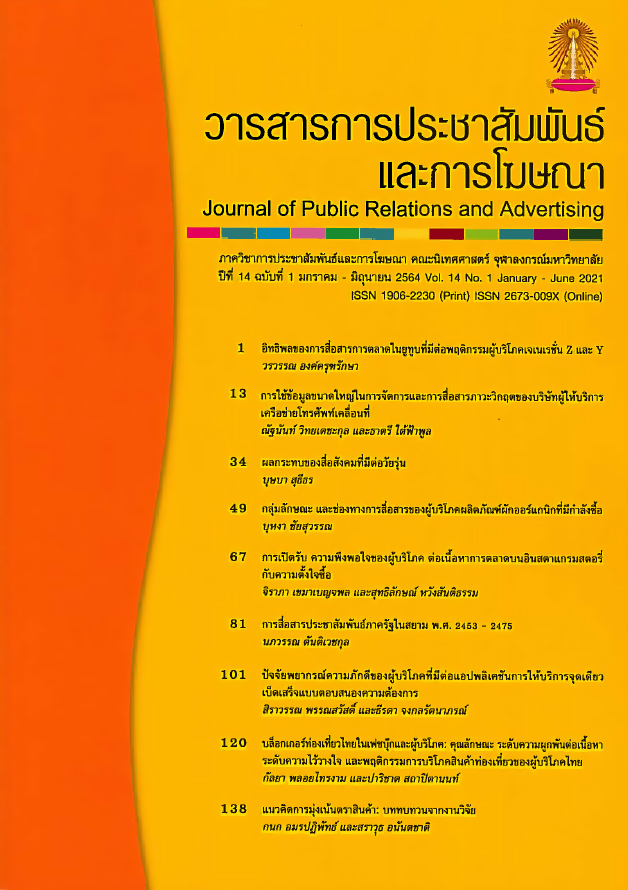Thai Travel Bloggers on Facebook and their Consumers: From Characteristics, to Brand Engagement, Trust And Thai Consumers’s Behavior on touristic products
Main Article Content
Abstract
The purpose of this research is to know 1) To analyze level of perception characteristics of travel bloggers, level of brand engagement on travel blogs, level of trust of travel bloggers and Thai consumers’ behavior on touristic products by differentiation of demographic. 2) To study the correlation of level of perception characteristics of travel bloggers, level of brand engagement on travel blogs and level of trust of travel bloggers. 3) To study the correlation of level of trust of travel bloggers and Thai consumers’ behavior on touristic products. The quantitative research was conducted via online questionnaires to collect data from 400 respondents.
The results of this research show that: 1) Thai consumers have level of perception characteristics of travel bloggers, level of brand engagement on travel blogs and behavior on touristic products overall is moderate but Thai consumers have level of trust of travel bloggers overall is high. 2) Thai consumers of different age and occupation have different level of perception characteristics of travel bloggers. 3) Thai consumers of different age have different level of brand engagement on travel blogs. 4) Thai consumers of different sex, age, income and status have different behavior on touristic products. 5) Characteristics of travel bloggers, level of brand engagement on travel blogs has correlation with level of trust of travel bloggers. The correlation was positive but at a low level. 6) Level of trust of travel bloggers has correlation with behavior on touristic products. The correlation was positive but at a moderate level.
Article Details
References
การท่องเที่ยวแห่งประเทศไทย. (2562). รายงานฉบับสมบูรณ์โครงการสำรวจพฤติกรรมการเดินทางท่องเที่ยวของชาวไทย. วันที่เข้าถึงข้อมูล 13 มีนาคม 2563 แหล่งที่มา https://intelligencecenter.tat.or.th/articles/8612
ชัญญาพร แสงตะโก (2560). อิทธิพลของ Micro-Influencer ต่อการตัดสินใจซื้อสินค้า High Involvement ประเภทรถยนต์นั่งส่วนบุคคล. การค้นคว้าอิสระนิเทศศาสตรมหาบัณฑิต สาขาวิชาการสื่อสารการตลาดดิจิทัล มหาวิทยาลัยกรุงเทพ.
เลิฟล็อก และ ไรท์. (2546). การตลาดบริการ = Principles of service marketing and management. อดุลย์ จาตุรงคกุล,
ดลยา จาตุรงคกุล และพิมพ์เดือน จาตุรงคกุล แปลและเรียบเรียง. กรุงเทพฯ : เพียร์สันเอ็ดดูเคชั่นอินโดไชน่า.
ศศิมา อุดมศิลป์. (2557). กลยุทธ์การสื่อสารการตลาดโดยใช้ผู้ทรงอิทธิพลออนไลน์ในธุรกิจ.ร้านอาหาร. วิทยานิพนธ์ปริญญามหาบัณฑิต, จุฬาลงกรณ์มหาวิทยาลัย, กรุงเทพฯ.
สุวีร์ณัสญ์ โสภณศิริ. (2554). การวิเคราะห์พฤติกรรมนักท่องเที่ยว. กรุงเทพมหานคร: อินทนิล.
สุดารัตน์ แสงแก้ว ปิยวรรณ สิริประเสริฐศิลป์ และ ปรีดา ศรีนฤวรรณ. (2561). คุณลักษณะและความชัดเจนของผู้มีอิทธิพลทางการตลาด: กลุ่มผู้นำทางความคิด. Chulalongkorn Business Review, 40(3), 1-2.
อรวรรณ วงศ์แก้วโพธิ์ทอง. (2553). Social Media เครื่องมือเพิ่มศักยภาพทางธุรกิจ. Executive Journal, 30(1), 63-64.
อัจฉิรา ทิวะสิงห์, พิมพกา ทองรมย์, พิมอร แก้วแดง และคณะ. (2562). พฤติกรรมการตัดสินใจท่องเที่ยวและการใช้สื่อสังคมออนไลน์ของนักท่องเที่ยวไทย. วิทยานิพนธ์ปริญญามหาบัณฑิต, มหาวิทยาลัยเทคโนโลยีราชมงคลธัญบุรี, กรุงเทพฯ.
อริชัย อรรคอุดม. (2552). การพัฒนาแนวคิดและมาตรวัดต้นแบบตราสินค้า เพื่อประยุกต์ใช้เชิงการสื่อสารการตลาด. วิทยานิพนธ์ดุษฎีบัณฑิต ภาควิชาประชาสัมพันธ์ คณะนิเทศศาสตร์ จุฬาลงกรณ์มหาวิทยาลัย, กรุงเทพฯ.
อินโฟเควสท์ (2563). ภูมิทัศน์สื่อไทย พ.ศ. 2563. วันที่เข้าถึงข้อมูล 9 เมษายน 2563, แหล่งที่มา https://www.infoquest.co.th/download-thailand-media-landscape-2020
แอด แอดดิท. (2563). Digital Thailand 2020: สรุป 30 สถิติดิจิทัลของคนไทย ประจำปี 2020 ฉบับรวมครบจบในที่เดียว. วันที่เข้าถึงข้อมูล 20 เมษายน 2563, แหล่งที่มา https://adaddictth.com/2020/02/19/digital-thailand-2020/
Barger, V., Peltier, W., J. and Schultz, E., D. (2016) Social media and consumer engagement: a review and research agenda. Journal of Research in interactive Marketing. 10(4), .268-287.
McEwen, W.J. (2005). Married to the brand: Why customers bond with some brands for life. New York: Gallup Press, 67.
Solomon, M.R. (2015). Consumer behavior: Buying having, and being (11th ed., Global ed.). Upper Saddle River, NJ: Prentice Hall.


